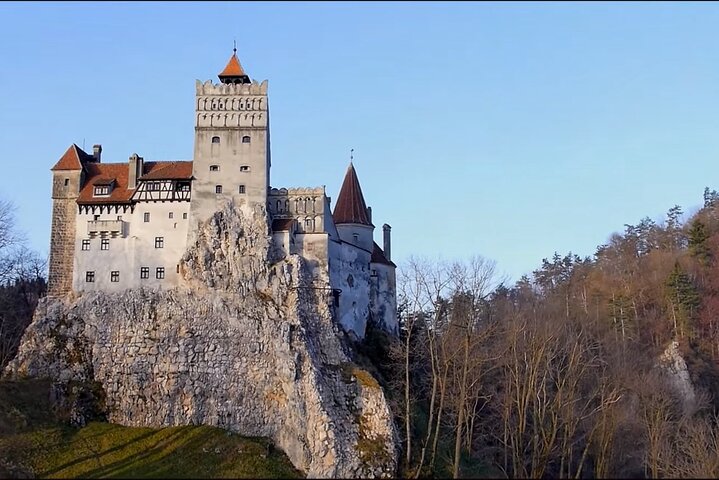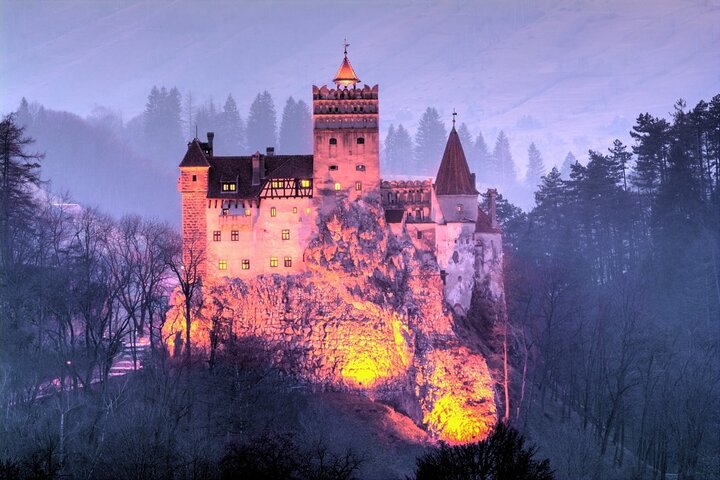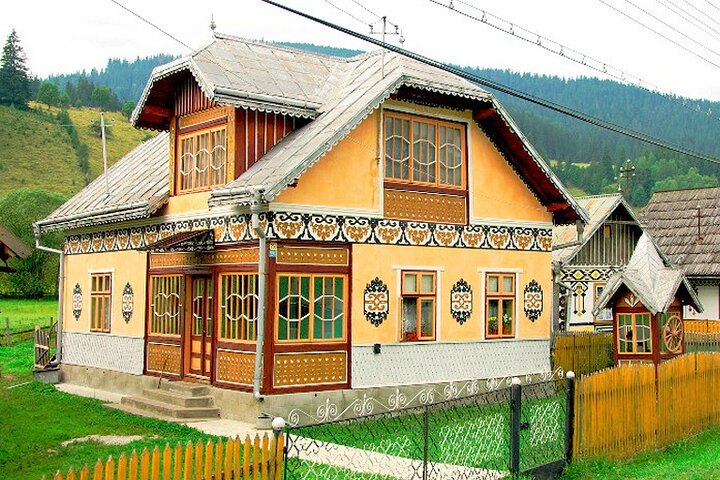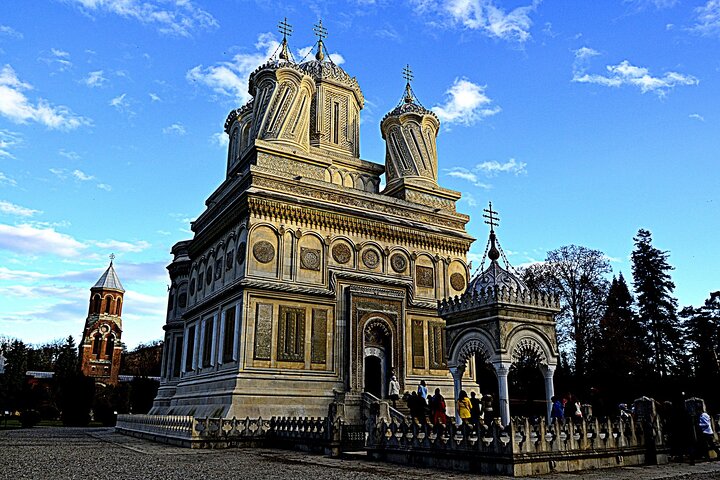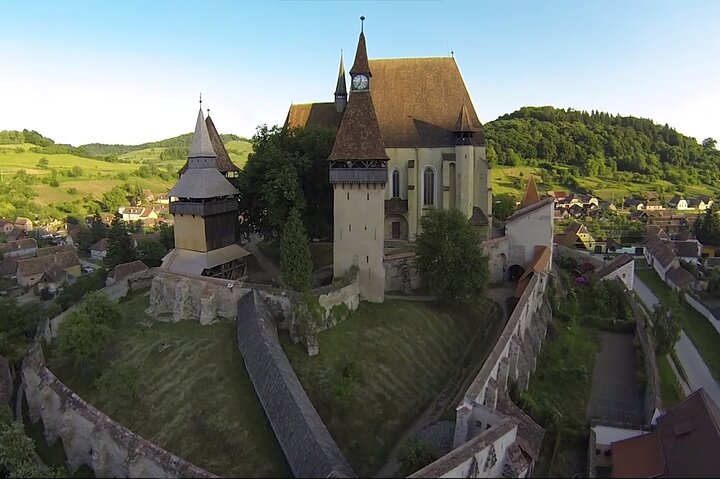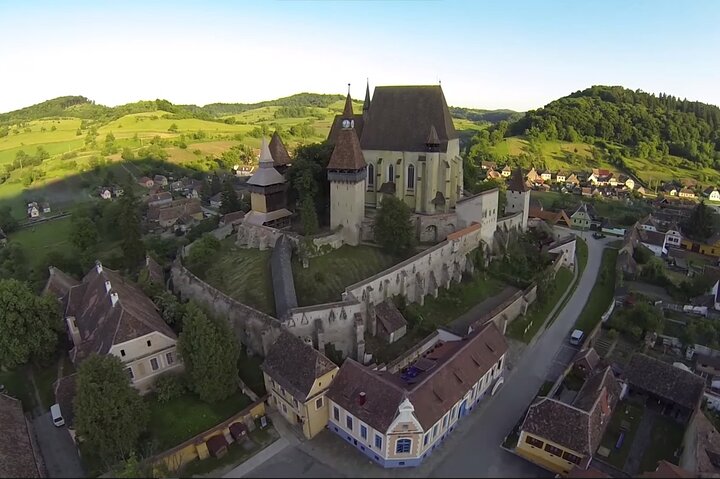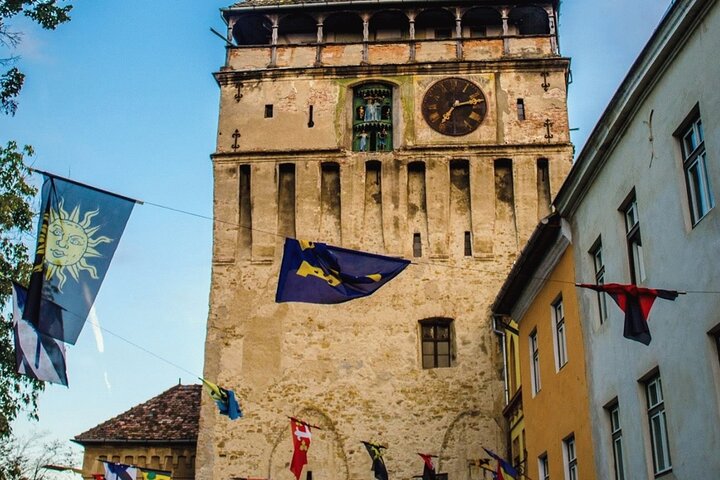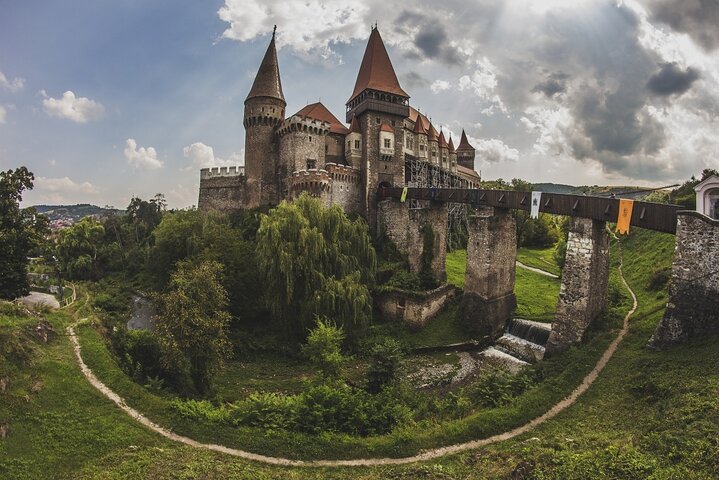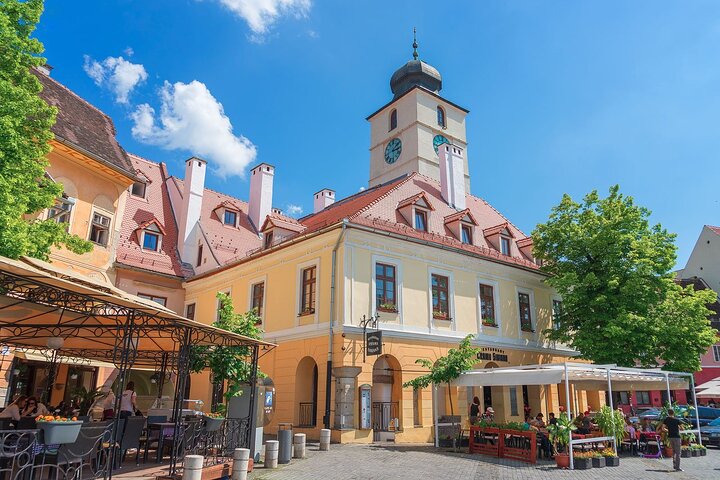7 Days Private Guided Tour in Romania from Bucharest
Share this tour

Offered languages
- German
- English
- Italian
- French
- Spanish
This seven days tour in Romania, gives us the chance to cover ancient history by visiting medieval castles, fortified churches and find stories that only few people know.
If you like to see the real Romania with one of the best guides in Romania, to have fun and to discover yourself, you just need to book this tour!
Good luck!
What's Included
Meeting and pickup
Please let us know the pick-up location! We'll pick you up from any location in Bucharest or near Bucharest!
Itinerary
-
1Peles Castle
Once upon a time there was a beautiful castle… If have decided to write your memoirs or you want to brag about having seen the most beautiful castles in Europe, the Romanian royal family’s summer residence is, by far, one of the most important tourist attractions in Romania and in Europe, and you will soon understand why. Every year, thousands of important figures and hundreds of thousands of tourists book tours of Romania for this attraction alone, to admire its beauty and at least for a few hours, feel like royalty.
2 hours • Admission ticket not included -
2Manastirea Sinaia
In your private tour in Romania, you will visit the most beautiful mountain resort, a place where many kings and important figures came to unwind and reflect, Sinaia Monastery is where you have the chance to escape reality and taste the simplicity and richness of orthodox spirituality, beautifully expressed in the artistic representations of this house of worship.
30 minutes • Admission ticket not included -
3Brasov Historical Center
This is a place that you need to visit, it's the main attraction in Brasov, next to the Black Church! Here we'll spend a few hour and we'll admire the buildings!
2 hours • Admission ticket free -
4Bran Castle (Dracula's Castle)
Bran Castle, between myth and history.. Because his fictional portrayal of Dracula’s castle matches Bran so closely, it is widely believed that Bram Stoker must have used descriptions of it to create the fictitious home of Count Dracula. Outside the castle, you’ll have the chance to try an array of traditional foods: handmade cheeses, pálinka (plum and pear brandy), and traditionally-produced ham and sausages.
2 hours • Admission ticket not included -
5Centrul Istoric Sighisoara
Did you know that Sighisoara’s citadel was built in the 12th century? If you want to go back in time and catch a glimpse of what life was like in the Middle Ages, you absolutely have to visit the Sighisoara Citadel, Romania’s medieval town, and Count Dracula’s (actually, Vlad the Impaler) place of birth. Built in 1280, the Sighisoara Citadel is not just one of the most visited tourist attractions in Romania, it is a living, breathing medieval fortress, since it has remained inhabited for over 700 years – which is quite rare.
2 hours • Admission ticket not included -
6Sighisoara Clock Tower
The multicoloured-tiled roof of Sighişoara’s Clock Tower glitters like the scales of a dragon. The tower was built in the 14th century and expanded 200 years later. It remains the prettiest sight in town, offering a magnificent panorama from the top. The views are as good a reason to visit as the museum inside, a patchy collection of Roman vessels, scythes and tombstones, and a scale model of the fortified town (English-language explanation is variable).
30 minutes • Admission ticket not included -
7Village de Viscri
With a history that goes back to the 12th century, Viscri is maybe the most famous village in Romania. Prince Charles’ visits, its fortified church, and the activity of the Mihai Eminescu Trust helped this small village reinvent itself in the past years. Its promotion was such a success that Viscri is right now one of Transylvania’s must-see attractions.
1 hour 30 minutes • Admission ticket free -
8Big Square (Piata Mare)
The Large Square is the largest of the squares of Sibiu, opening a wide perspective, typical to the Renaissance and the following ages. Here we have the historical centre of Sibiu, mentioned for the first time in 1411 as a grain market. The Large Square exits since 1366, alongside the finalization of the third fortification belt of the city. Starting with the 16th century, the Large Square becomes the centre of the citadel.
1 hour • Admission ticket free -
9Catedrala Ortodoxa Sfanta Treime
Don’t miss this beautiful church in Sibiu If you ever wanted to see o small-scale copy of the Sofia Cathedral in Constantinople, now you have the chance to see it during this trip to Sibiu. This 110-year old historical house of worship is the only orthodox cathedral in Sibiu, but it looks more like a byzantine basilica.
30 minutes • Admission ticket not included -
10Lutheran Evangelical Cathedral & Tower
We should definitely visit the Sibiu Evangelical Cathedral, an important historical monument, as part of tour of Sibiu, the citadel town.
45 minutes • Admission ticket free -
11Biertan Fortified Church
The Biertan fortified church (Romanian: Biserica fortificată din Biertan; German: Kirchenburg von Birthälm) is a Lutheran fortified church in Biertan (Birthälm), Sibiu County, in the Transylvania region of Romania. It was built by the ethnic German Transylvanian Saxon community at a time when the area belonged to the Kingdom of Hungary. Briefly Roman Catholic, it became Lutheran following the Reformation. Together with the surrounding village, the church forms part of the villages with fortified churches in Transylvania UNESCO World Heritage Site.
1 hour • Admission ticket not included -
12Densus Church
The next architectural piece is one of the oldest orthodox churches in Romania, this historical monument was built on top of the ruins of a building dating back to the 4th century, and it was constructed in several stages, the final changes having been made in the 13th century. You will marvel at the mixture of styles, which have blended over the centuries in this ancient “temple”, having also been proposed to join the UNESCO Heritage list of historical sites. Nicolae Iorga, the greatest Romanian historian, has deemed the Saint Nicolae Church in Densus “unparalleled in the entire Romanian tradition”. Here you can admire mural paintings dating back to 1443, inside an ingenious construction which has striven to preserve its history throughout each stage. There is more to see than to be told, so we will let you discover the details yourself.
30 minutes • Admission ticket not included -
13Castelul Corvinilor
This private trip to Romania gives you the opportunity to get a taste of what medieval life was like in Romania in the time of knighthood, castles and fortresses with a visit to The Corvin/Hunyadi Castle, one of the top 10 most beautiful gothic castles in the world. This architectural masterpiece is one of the largest castles in Europe and one of the seven wonders of Romania, and it has served a double purpose since the 15th century. After a devastating fire, the castle underwent extensive restoration and is now open to the public as a museum. A small tip: the defense towers are a great spot to take a selfie.
2 hours • Admission ticket not included -
14
The miracle from the Minis Canyon… Words fall short when it comes to describing the untamed, primordial splendor of the breathtaking Bigar Waterfall and its surroundings resembling the Garden of Eden. It is not surprising that it was voted as the most beautiful waterfall in the world. But do not take our word for it. Decide for yourself, as you are breathing in the fresh and invigorating air and watching the water seep onto the moss-covered rocks, creating a mesmerizing veil of translucent beauty.
30 minutes • Admission ticket free -
15Iron Gates
The adventure continues in an area inhabited by tens of thousands of years, where the Danube seems to boil due to currents. The pretext of our trip here I give both the Danube Gorge, the breathtaking and some engineers and technicians brave, which in order of communist rule in 1960, began one of the most daring engineering works, what is called the Iron Gates and worth admired.
1 hour • Admission ticket free -
16
Not everyone knows about the great king Decebalus and his and acts of bravery, but his fearlessness and determination to protect his country have earned him this extraordinary monument carved out in the side of a mountain cliff, 128 meters above the restless Danube and the Kazan Gorge. Near the city of Orsova, where the Danube reaches 120 m in depth and it starts to whirl and tremble as if boiling, the amazing masterpiece that took 10 years to build dominates the rocky scenery, as a testament to the thousands of years of Romanian history on these lands. This is also the place where scientists have uncovered some of the earliest traces of human life, estimated to be over 35.000 years old. Here you can also find commemorative plaques from ancient Roman times, such as the Tabula Trajana. Imagine how impressed your friends would be to see a picture of you with Decebalus’ stone-carved head in the background?
45 minutes • Admission ticket free -
17
In this adventure we will visit some Roman ruins at the mouth of the Danube, admiring the scenery and wilderness, also the ancient roman bridge!
1 hour • Admission ticket free -
18
The ensemble consists of four sculptures, laid out on a 1275 m axis – The Table of Silence, The Chairs Alley, The Gate of the Kiss and the Infinity Column/Endless Column, which surprise through their simple, yet deeply symbolic design. Find out what other treasures you can uncover during your Romanian experience in Targu Jiu.
20 minutes • Admission ticket free -
19
Even if you do not harbor a passion for sculptural masterpieces, a Brancusi exhibit is a must-see for anyone taking a trip to Romania. The Constantin Brancusi Sculptural Ensemble in Targu Jiu, also known as the “Calea Eroilor” Memorial (Heroes’ Way), is more than a beautiful display of stone and wood craftsmanship, it is a symbol of the Romanian spirit.
20 minutes • Admission ticket free -
20
The ensemble consists of four sculptures, laid out on a 1275 m axis – The Table of Silence, The Chairs Alley, The Gate of the Kiss and the Infinity Column/Endless Column, which surprise through their simple, yet deeply symbolic design.
30 minutes • Admission ticket free -
21Horezu Monastery (Hurezi Monastery)
Considered one of the most beautiful and refined orthodox monasteries, the Horezu Monastery with its 100% authentic Romanian architecture was included in the UNESCO World Heritage from the very beginning, with no sign that anything could ever surpass it. Your private trip to Romania should comprise, among other things, the most visited Romanian monasteries, including the Horezu Monastery, because this is where you can see the highly acclaimed Horezu ceramics, as well as the gorges carved in the mountain walls and the famous stone caves.
30 minutes • Admission ticket free -
22Polovragi Cave
The cave is located at the foothills of the Carpathian Mts, in the Oltet Gorges; not far from Transalpina (Romania's highest alpine road), near Horezu.
1 hour • Admission ticket not included -
23Poienari Castle
If we were to put together a tour of the castles in Romania for Dracula fans and adventure lovers, Poenari Castle would have to be on the list, being an important Romanian tourist attraction. Poenari Fortress is a ruined castle in Romania situated at a height of 860 meters known for the bound to Vlad the Impaler. As you are climbing up the 1480 stairs that lead up to the castle, you can rightfully say you are following in the steps of Dracula …
2 hours • Admission ticket not included -
24Vidraru Dam
Vidraru Dam is a dam in Romania. It was completed in 1966 on the Argeș River and creates Lake Vidraru. The arch dam was built with the primary purpose to produce hydroelectricity. The dam's height is 166 metres, the arch length 305 meters and it can store 465 million cubic metres of water. The reservoir has a total shoreline (perimeter) length of 28 km.
15 minutes • Admission ticket free -
25Curtea de Arges Monastery
The Cathedral of Curtea de Argeș (early 16th century) is a Romanian Orthodox cathedral in Curtea de Argeș, Romania. It is located on the grounds of the Curtea de Argeș Monastery, and is dedicated to Dormition of the Mother of God. The building is the seat of the Archdiocese of Argeș and Muscel. The cathedral is faced with pale grey limestone, which was easily chiselled then hardened on exposure. The interior is of brick, plastered and decorated with frescoes. Nearby on the grounds stands the large Neo-Romanian style Royal Palace built in late 19th century.
45 minutes • Admission ticket not included
1. Peles Castle 2. Sinaia Monastery 3. Old Town Brasov - Overnight in Brasov
1. Bran Castle / Dracula's Castle 2. Sighisoara Citadel Private Tour 3. Viscri Village - Overnight in Sibiu
1. Biertan Church 2. Sibiu City Tour 3. Orthodox Cathedral 4. Evangelical Cathedral in Sibiu - Overnight in Hunedoara
1. Densus Temple 2. Corvin's Castle 3. Bigar Waterfall 4. Overnight in Drobeta Turnu Severin
1. Iron Gate River Cruise 2. Rock-Carved Statue of Decebal 3. Roman Ruins 4. Overnight in Drobeta Turnu Severin
1.Constantin Brancusi Sculptural Ensemble Targu Jiu 2. Horezu Monastery 3. Polovragi Cave 4. Overnight in Ramnicu Valcea
1. Poienari Fortress 2. Vidraru Dam 3. Curtea de Arges Monastery 4. Back to Bucharest
Additional info
- Service animals allowed
- Suitable for all physical fitness levels
Tags
Cancellation Policy
For a full refund, cancel at least 24 hours before the scheduled departure time.
Show more
Cancellation Policy
- For a full refund, you must cancel at least 24 hours before the experience’s start time.
- If you cancel less than 24 hours before the experience’s start time, the amount you paid will not be refunded.
- Any changes made less than 24 hours before the experience’s start time will not be accepted.
Rating
You can cancel up to 24 hours in advance of the experience for a full refund.
Your guide to the flawless travel experience








